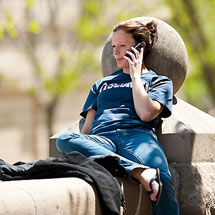UW-Madison students well-connected, with smaller devices
The old Mac-versus-PC and laptop-versus-desktop debates have given way to cell phone versus smart phone for University of Wisconsin–Madison students.

Just under half of UW–Madison students own a smart phone — almost double the number in 2009.
Photo: Bryce Richter
Just under half of UW–Madison students own a smart phone (handheld Internet device) — almost double the number in 2009. More importantly, these students are expecting their UW course, records and collaboration tools to be seamlessly accessible on these devices.
These are among the findings of the 2010 Student Computing Survey, conducted by UW–Madison’s Division of Information Technology. The purpose of the annual survey is to monitor trends in information technology, gauge usage of UW–Madison’s technology products and services, and to gather feedback on ways to improve those products and services.
“Keeping up with student expectations is always a challenge,” says Joanne Berg, interim CIO at Madison. “Our annual surveys and focus groups go a long way toward at least keeping us close. We use the data to not only determine what technologies to retire or explore, but also to anticipate demand for our IT systems.”
Overall, students place high demand on the latest technologies for their schoolwork and everyday use. Among their most popular tools are Web-based e-mail (81 percent), Internet long-distance services (53 percent), Web-based applications and documents (49 percent), and music-hosting services (49 percent).
Usage patterns are similar for handheld devices. Half the handheld owners use their device to access the campus wireless network. Eighty-one percent use their device to check information (news, weather, sports, specific facts) and 70 percent for social networking Web sites (Facebook, MySpace, Bebo, LinkedIn). Some students report using Facebook for classroom and personal needs.
Students are coming to expect features found on Web-based commercial tools to also be available in UW–Madison-provided resources.
One example is new uses for global positioning service (GPS) features found in many handheld devices. Heavy users expect it to not only show them where they are in terms of an address, but also in terms of a room in a campus building and a class that meets in the room.
The campus is responding to changing expectations observed through the survey.
“We are working on a map ‘app’ for smart phones that goes beyond commercially available maps,” says Hideko Mills, lead for the UW Mobile Apps project. “Map use — even online — is changing. There is a growing expectation to combine campus location, directions and related information. We hope to make such an app available later this fall.”
According to the 2010 survey, students continue to be quite happy with the technology UW–Madison provides, with 86 percent reporting they are satisfied or very satisfied. Topping the satisfaction list are the campus wireless network, campus computer kiosks and academic software discounts.
Other findings from the 2010 Student Computing Survey show:
- Awareness of IT security issues is increasing. Sixty percent updated or patched their computer software in the last month, and 95 percent know not to respond to unsolicited requests for personal information (phishing scams).
- Eighty percent of students report being aware of the issue of illegally downloading music and movies (copyright infringement) on campus, and 75 percent are aware of the penalties for downloading material illegally.
- More than 90 percent of students have taken a course that used Learn@UW, UW–Madison’s Web-based course-management software.
Among top improvements requested by students are more user-friendly access to data; faster and greater access to wireless; more software training classes; and access to UW–Madison services on handheld Internet devices.
The survey was conducted in the spring semester, with a random sample of 1,200 UW–Madison students. The response rate was 31 percent.
The full report is available at http://www.doit.wisc.edu/about/research/.



